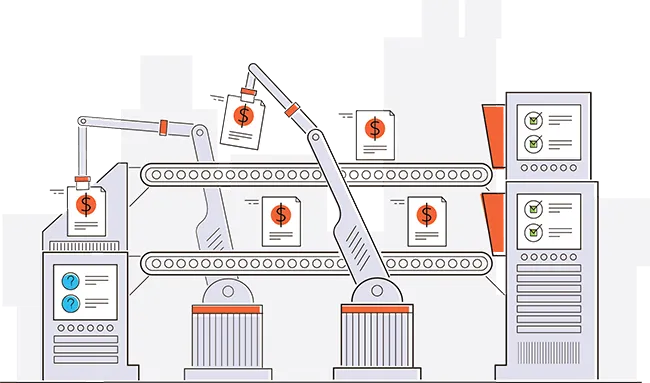What is business process automation? Benefits, examples, and how to get started
Table of contents

Business process automation (BPA) software uses business rules and automated tasks to perform processes that accomplish a specific business goal. The goal could be as simple as allowing an employee to request vacation time or as complex as developing a new product. All activities around these processes are tracked and analyzed for efficiency.
Why is this important? Simply put, humans make mistakes and are the key drivers of innovation in any business because the software can’t think for itself. This means that when your employees spend time on repetitive processes instead of thinking of ways to grow your business, you risk manual errors (that must be corrected with additional time) for little benefit. Hence, process automation reduces errors and frees up your employees’ time and energy, in addition to improving efficiency.
Why is business process automation software used?
By automating business processes, especially those that are traditionally handled manually, significant benefits can be realized:
- Greater productivity
- Improved job satisfaction
- Increased efficiency
- Full audibility and tracking
- Improved accuracy
Automation is often part of a business process management suite that includes other tools to help define, model, test and manage a portfolio of business processes.
Several process automation applications are available in the automation ecosystem today, and which ones you use will heavily depend on your business, your industry, and the various challenges you’re experiencing. However, the benefits of process automation through software, applications, and other tools are universal. They should be a goal of any company looking to grow and cut costs without sacrificing the quality of work.
This post will walk through the value of automation software and how your business can use these various automation applications and tools.
How to build an automated process
Using a drag-and-drop user interface (UI), automated processes are designed to follow existing processes or improve them. In most cases, the process is documented using a process modeling tool and then reviewed by all stakeholders for accuracy. Once the static design is approved, work begins by designing the process, including forms, tasks, recipients, alerts/notifications, etc. This is done using business process solutions that include prebuilt tasks (complete form, submit approval, hand off to another person, etc.) that can be arranged sequentially or in parallel.
Modern BPA platforms integrate seamlessly with document management systems, enabling automated document workflows, digital signature processes, and compliance management.
Video: Build an automated process in under 5 minutes
Process builders can insert business rules between tasks that decide the path. For instance, you may set up a business rule that automatically routes a capital budget request to the CFO if it’s more than $50,000. Or, you might route a form back to the submitter if the reviewer needs more information. These rules are critical to managing the flow of tasks in a non-linear workflow. Whatever your organization’s choice of BPA applications, you should be able to set up workflows that follow this simple path-based architecture.
Launching new processes with process automation tools
Once processes are built and tested, it’s time to roll them out to your users. In some cases, this could be the entire employee population; in other cases, it could be a single department, outside vendors, or customers. In most automation applications, access to processes is provided through a web portal where users can submit requests, check statuses, or complete tasks depending on their role. This self-service portal houses all procedures and forms, but many employees will also interact through email alerts.
For instance, a manager may receive an email alert indicating approval is needed for a new hire. The manager clicks “Approve” in the email, and the BPA system updates the task and moves forward with the next step.
Meanwhile, the employee who submitted the approval request can track its status throughout its journey. When an organization has multiple approval levels and gatekeepers, this becomes extremely valuable for the requester. It also reduces the need for phone calls, status updates, and emails to find an answer.
Business process automation software examples
Broadly, BPA is used for task management, employee/customer service, operations management, and business process compliance. Any department in your business operating with manual processes — from sales and marketing, to IT — can benefit significantly from adopting the right software and using the proper tools.
Here are some specific examples of processes that can benefit from automation solutions:
| IT/IS | Finance | Marketing |
|---|---|---|
| Security incidents | CapEx/AFE requests | Campaign approvals |
| Security access requests | Expense approvals | Collateral approvals(opens in a new tab) |
| New project requests | Salary/wage changes | Brand management |
| New account setup | AP automation | |
| IS service requests | ||
| Change requests |
| Facilities | Sales | Legal |
|---|---|---|
| Resource scheduling | Quote approvals | Legal holds |
| Office relocations | Pricing discounts(opens in a new tab) | Contract reviews |
| Move requests | Proposal approvals | Client intake |
| Facility access | Product discounts |
| Human resources | Purchasing |
|---|---|
| Benefits changes | General procurement |
| Timesheets | Capital approvals |
| New hire management(opens in a new tab) | Vendor management |
| Employee onboarding | Invoice approvals |
| Employee offboarding | Product pricing |
| Vacation requests |
Video: BPA software from Nutrient Workflow
Why automated vs. manual processing?
There are many reasons why automated processing is superior to manual methods. While an automated system can never replace employees’ intelligence and non-linear thinking, it can reduce the time employees spend performing tedious and unrewarding tasks that steal time from more important work.
Here are just a few of the advantages of automated processing:
- Reduced manual handling
- Reduced errors
- Reduced approval cycles
- Policy compliance adherence
- Improved visibility
- Improved employee satisfaction
- Continual process improvement
- Better workload management
You will, at some point, hear that automation systems may jeopardize certain positions and roles. While this can sometimes happen, in our experience, it leads to people being able to focus on more value-add activities.
Who owns your processes?
While IT or the business applications team might be responsible for managing the automation software, ownership of the processes themselves is broader — as with any digital transformation. To truly achieve operational efficiency, everyone involved in the strategy should share ownership.
Through “citizen development” and collective process improvement, departments and organizations truly streamline processes and provide reduced operational costs. Anyone associated with the process can provide ideas and feedback to help reduce friction and avoid bottlenecks and rework.
It also means that some employees who lack development skills but are technically inclined and understand the full scope of the process can edit the automation by adding tasks, changing assignments, and routing information.
What about robotic process automation?
Solutions like Nutrient Workflow can be integrated with robotic process automation (RPA) software to manage workflows and simulate human-centric tasks like entering data, moving between applications, analyzing documents, etc.
RPA integration can be a powerful boost to any process application suite because it reduces the necessary work you need to rely on your human team members. This not only reduces the chances of human error; it also frees up your employees and managers to do other work rather than spending time on processes.
Looking for the ROI on technology-enabled automation for business?
We’ve produced several tools that show the return on investment you’ll gain when switching from manual to automated workflow across the enterprise. We hope you’ll be convinced of the need for automation in general and the need to use reliable, powerful software and tools to make the process streamlined and effective.
FAQ
BPA uses software to automate repetitive tasks and processes, improving efficiency and accuracy, and freeing up employees for more strategic activities.
Benefits include greater productivity, improved job satisfaction, increased efficiency, full auditability, and improved accuracy in business processes.
Nutrient Workflow’s BPA software uses a drag-and-drop interface to design processes, automate tasks, set business rules, and manage workflows through a centralized portal.
Processes across various departments such as IT, finance, HR, marketing, and sales can be automated, including approvals, requests, and task management.
Automated processing reduces manual handling, errors, approval cycles, and compliance risks, while improving visibility, employee satisfaction, and overall process efficiency.







